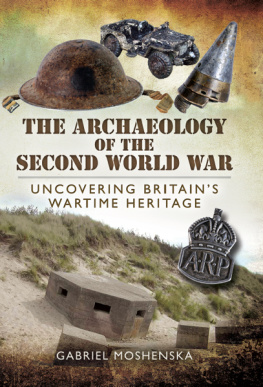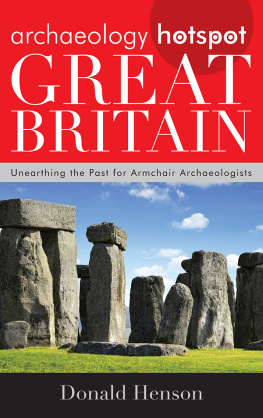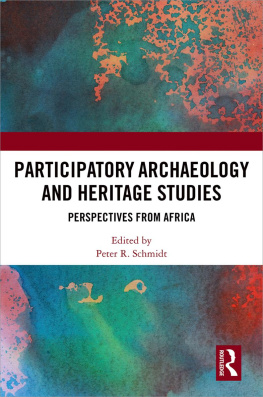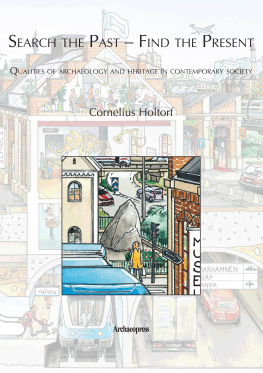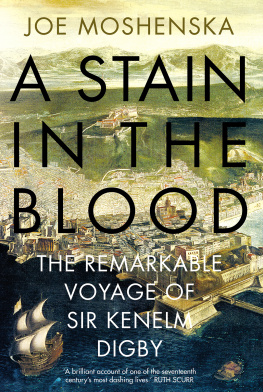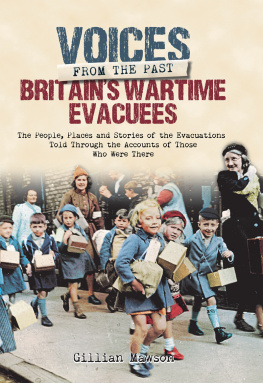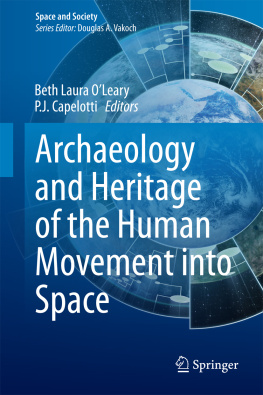Gabriel Moshenska - The Archaeology of the Second World War: Uncovering Britains Wartime Heritage
Here you can read online Gabriel Moshenska - The Archaeology of the Second World War: Uncovering Britains Wartime Heritage full text of the book (entire story) in english for free. Download pdf and epub, get meaning, cover and reviews about this ebook. year: 2013, publisher: Pen & Sword Archaeology, genre: Politics. Description of the work, (preface) as well as reviews are available. Best literature library LitArk.com created for fans of good reading and offers a wide selection of genres:
Romance novel
Science fiction
Adventure
Detective
Science
History
Home and family
Prose
Art
Politics
Computer
Non-fiction
Religion
Business
Children
Humor
Choose a favorite category and find really read worthwhile books. Enjoy immersion in the world of imagination, feel the emotions of the characters or learn something new for yourself, make an fascinating discovery.
- Book:The Archaeology of the Second World War: Uncovering Britains Wartime Heritage
- Author:
- Publisher:Pen & Sword Archaeology
- Genre:
- Year:2013
- Rating:5 / 5
- Favourites:Add to favourites
- Your mark:
- 100
- 1
- 2
- 3
- 4
- 5
The Archaeology of the Second World War: Uncovering Britains Wartime Heritage: summary, description and annotation
We offer to read an annotation, description, summary or preface (depends on what the author of the book "The Archaeology of the Second World War: Uncovering Britains Wartime Heritage" wrote himself). If you haven't found the necessary information about the book — write in the comments, we will try to find it.
Gabriel Moshenska: author's other books
Who wrote The Archaeology of the Second World War: Uncovering Britains Wartime Heritage? Find out the surname, the name of the author of the book and a list of all author's works by series.
The Archaeology of the Second World War: Uncovering Britains Wartime Heritage — read online for free the complete book (whole text) full work
Below is the text of the book, divided by pages. System saving the place of the last page read, allows you to conveniently read the book "The Archaeology of the Second World War: Uncovering Britains Wartime Heritage" online for free, without having to search again every time where you left off. Put a bookmark, and you can go to the page where you finished reading at any time.
Font size:
Interval:
Bookmark:
First published in Great Britain in 2012 by
Pen & Sword Archaeology
an imprint of
Pen & Sword Books Ltd
47 Church Street
Barnsley
South Yorkshire
S70 2AS
Copyright Gabriel Moshenska 2012
ISBN 978 1 84884 641 8
EPUB ISBN: 978 1 47382 230 6
PRC ISBN: 978 1 47382 182 8
The right of Gabriel Moshenska to be identified as Author of this Work has been
asserted by him in accordance with the Copyright, Designs and Patents Act 1988.
A CIP catalogue record for this book is available from the British Library.
All rights reserved. No part of this book may be reproduced or transmitted in any
form or by any means, electronic or mechanical including photocopying, recording
or by any information storage and retrieval system, without permission from the
Publisher in writing.
Typeset in Ehrhardt by Phoenix Typesetting, Auldgirth, Dumfriesshire
Printed and bound in India by Replika Press Pvt. Ltd.
Pen & Sword Books Ltd incorporates the Imprints of Pen & Sword Aviation, Pen &
Sword Family History, Pen & Sword Maritime, Pen & Sword Military, Pen &
Sword Discovery, Wharncliffe Local History, Wharncliffe True Crime, Wharncliffe
Transport, Pen & Sword Select, Pen & Sword Military Classics, Leo Cooper, The
Praetorian Press, Remember When, Seaforth Publishing and Frontline Publishing
For a complete list of Pen & Sword titles please contact
PEN & SWORD BOOKS LIMITED
47 Church Street, Barnsley, South Yorkshire, S70 2AS, England
E-mail:
Website: www.pen-and-sword.co.uk
Contents
This book is dedicated to my grandparents
Acknowledgements
This book is the result of many years of digging, studying, reading, chatting and arguing about Second World War archaeology, and along the way I have met and worked with many brilliant and dedicated people. I am grateful to my colleagues and friends who have volunteered to work on my excavations over the years, enduring mud, misery and the general public in return for little more than tea, cakes and my undying gratitude, including Sarah Dhanjal, Susan Holmes, Don Cooper, Andrew Coulson, Morag McBride, Jim Nelhams, Andy Agate, Guy Taylor, Hannah Page, Jo Ward and Sarah Doherty. I have also been fortunate to have been allowed to work on other peoples Second World War excavations in a variety of roles: my gratitude to Andy Brockman, Faye Simpson, Roy Stephenson, Peter Doyle and Larry Babits. Other colleagues have been kind enough to share stories, datasets and images with me, and several have given me permission to reproduce their photographs: my thanks to Nick Catford, Guy Taylor, Nathalie Cohen, James Dixon, Emily Glass and Andy Brockman.
My knowledge and understanding of the Second World War and its archaeological remains have benefited enormously from conversations and correspondence with a number of scholars and experts in the field. I am very grateful to John Schofield, Wayne Cocroft, Adrian Myers, Gus Milne, Gilly Carr, Martin Brown, Rod Scott, Neil Faulkner, James Dixon, Ross Wilson, Jon Price and Alfredo Gonzlez-Ruibal. My students on the MA course unit Archaeologies of Modern Conflict at UCL Institute of Archaeology have been inspirational, and their research project assignments have opened my eyes to the diversity of conflict heritage around the world. During my fieldwork on various Second World War sites I have been fortunate enough to have met many people who lived through the events that I was studying, and who were willing to share their stories with me and make their memories part of my research. Talking with these people and recording their memories has been an extraordinary privilege and a reminder of the importance of studying the Second World War while it is still a part of living memory.
Enormous thanks must also go to my family, who have fed my fascination with Second World War sites and artefacts, and who have been dragged around more museums than is probably reasonable including some particularly remote aviation museums. Thanks in particular to my parents, who read through early versions of the chapters of this book and gave excellent feedback and advice. I am massively indebted to Maria, who put up with my late nights, exhaustion and general crabbiness during the last stages of writing.
A final, special, thanks goes to Nick Saunders, who has been badgering me to write this book for many years, provided advice and support, and chivvied me on when I was dispirited about the whole project.
Preface
Every year in the Christmas holidays my parents drive out from Brighton to Cuckmere Haven near Seaford to walk the footpath that trails along the base of the valley to the sea, past grazing sheep and children riding new bicycles. As a small and energetic child, I ran up and down the valley and explored the rabbit warrens, ponds and old bunkers that line its sides. A few years later I canoed part of the stream that meanders down the central plain, and saw the remains of deep ditches lined with concrete cubes stretching from one side of the valley to the other. Over the years, as my interest in the Second World War developed and I began to learn the history of the area, I came to understand Cuckmere Haven as a defended landscape, a valley utterly transformed by the preparations for the German invasion of Britain. Today, thanks to the work of volunteer researchers and amateur and professional archaeologists who have studied and recorded the site, I have been able to appreciate Cuckmere Haven not only as a part of my family tradition but as one of the best preserved Second World War defensive landscapes in the country and an archaeological treasure-trove.
Nestled between high chalk cliffs, Cuckmere Haven with its sheltered beach and wide, flat valley bottom is a perfect landing site for an invading army heading inland towards London. The first anti-invasion defences on the site were built in 1804 in response to the threat from Napoleons army, while in the First World War the valley was used for training, and no doubt some of the trenches and ditches that criss-cross the hillsides date from this period. As the Second World War approached, the German military began to identify likely landing sites and Cuckmere Haven was allocated as a beaching spot for the 6th Mountain Division. Had the planned invasion ever taken place we now know what these troops would have faced as their landing craft approached the Sussex coast. Anti-tank guns high up on the hillsides would have opened fire before the troops had landed, and on the beaches they would have come under fire from machine guns and small-arms in pillboxes manned by 135 and 136 Infantry Brigades. Above the beaches the German soldiers would have found themselves in a minefield entangled in barbed wire. Tanks and other vehicles supporting the German advance would have met a wall of concrete blocks stretching from the top of one valley side to the other, and beyond this a network of wide, water-filled ditches blocking their advance. Any German troops who managed to fight their way past the barbed wire, mines, light and heavy gunfire, ditches, blocks and hidden pillboxes would have found themselves in a marshy valley bottom studded with peculiar structures including electric lights on poles hanging above pools of water. These were bombing decoys designed to resemble the nearby port of Newhaven as seen from the air at night-time, and thus to confuse the German Luftwaffe bombardiers into wasting their bombs on empty fields: another part of the militarised landscape of Cuckmere Haven.
As the threat of invasion faded, the drive to build ever-greater defences began to disappear, but troops remained to guard the most vulnerable spots against commando raids and other incursions. After the war the beaches and inland sites were cleared of mines and barbed wire, and most of the fittings were stripped out of the pillboxes. Defensive ditches were filled in so that the land could return to its peacetime agricultural uses. Pillboxes in inconvenient locations were pulled down, and the anti-invasion landscape of Britain began to fade into archaeology. It would be half a century before archaeologists turned their attention to Cuckmere Haven. In 1995 the Defence of Britain Project was established under the auspices of the Council for British Archaeology, and more than 600 volunteers set about recording the survival and states of preservation of Second World War sites around the country. By the time the project ended in 2002 more than 20,000 sites had been recorded, creating a database that will form the basis of all future research into the archaeology of the Second World War. In 2002 the Defence Areas Project began, using the data from the earlier study to identify places where entire anti-invasion landscapes had survived. This project identified Cuckmere Haven as perhaps the finest group of surviving coastal defence works, with pillboxes of differing types dug into the cliff sides, large anti-tank cubes, an anti-tank wall, and open sections of anti-tank ditch. Through this work the archaeological remains at Cuckmere Haven have been recorded and assessed: in recent years the data from these surveys have been used to prevent damage to the site by flooding, and to carry out repairs on the pillboxes on the site to prevent their deterioration. On my annual visits to Cuckmere Haven I walk the line of the anti-tank ditch, clamber over the dragons teeth blocks, and explore the litter-strewn interiors of the gun emplacements and bunkers. Here and there I find names or initials cut into the concrete and dates 1940, 1941 that remind me of the men who built the defences and those who manned them through the dark months early in the war when invasion seemed imminent. There are still people alive today who remember the erection of anti-invasion defences along the British coastline, and some who manned them. The archaeology and the records of those remains will serve as a testimony to the wartime generation long after they have passed; the duty of archaeologists is to bring the traces of the Second World War to life again to illuminate the lives and experiences of the people who worked, fought and died among them.
Next pageFont size:
Interval:
Bookmark:
Similar books «The Archaeology of the Second World War: Uncovering Britains Wartime Heritage»
Look at similar books to The Archaeology of the Second World War: Uncovering Britains Wartime Heritage. We have selected literature similar in name and meaning in the hope of providing readers with more options to find new, interesting, not yet read works.
Discussion, reviews of the book The Archaeology of the Second World War: Uncovering Britains Wartime Heritage and just readers' own opinions. Leave your comments, write what you think about the work, its meaning or the main characters. Specify what exactly you liked and what you didn't like, and why you think so.

